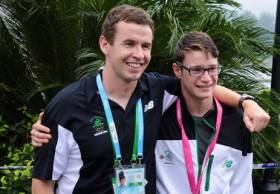Displaying items by tag: Jake Cochrane
Jake Cochrane's Bronze at C1 Men Final in Pyrenees Cup
Northern Ireland Canoeist Jake Cochrane won a bronze medal in the C1 Men Final earlier this month at the first race of the 2021 Pyrenees Cup, an ICF ranking series held in northern Spain and southern France.
The full-time Canoe Slalom athlete from Jordanstown showed great pace all weekend, starting with third in the qualification round, and carrying the momentum to his medal-winning performance with a clean run of 93.70 seconds in the final.
Also in action was 2012 Olympian Hannah Craig, who showed the strength of the Irish Team this year, making the finals of the K1 Women, finishing ninth.
The Pyrenees Cup is a series of races held in southern France and northern Spain, attracting a very high level of competition with international racers from all over Europe using the series to get their first start line of the year.
Hendrick Qualifies for World Championship Semi-Finals
#Canoeing: Robert Hendrick qualified for the semi-final of the C1 (Canadian canoe) at the canoe slalom World Championships at La Seu d’Urgell today.
The Kildare man took 10th place in his second run – just inside the crucial cut-off point. Hendrick’s 99.03 seconds with no time penalties put him in 11th in the first set of results, but Italy’s Roberto Colazingari was then given a 50-second penalty for missing a gate and dropped out of the top 10. Hendrick had made it through.
Hendrick will qualify Ireland for a place in the C1 in Tokyo 2020 if he can place in the top 11 nations in the semi-finals.
Liam Jegou finished 13th, missing out on a qualification spot because of a two-second penalty for a touch on gate 11. Jake Cochrane, who was less than half a second outside qualification in the first run, did not do so well second time around and finished 49th. He missed gate five and incurred a 50-second penalty.
Canoe Slalom World Championships, La Seu d’Urgell, Spain (Irish interest)
Men
C1 – First Run (top 20 qualify directly): 26 J Cochrane 99.72, 38 R Hendrick 103.68, 46 L Jegou 106.38. SECOND RUN (top 10 to semi-finals): 10 Hendrick 99.03; 13 Jegou 99.62, 49 Cochrane 151.72
Women
K1 – First Run (top 20 qualify directly): 72 H Craig 182.68, 75 A Conlan 195.02, 76 C O’Ferrall 245.62. SECOND RUN (top 10 to semi-finals): 41 Conlan 133.13, 45 O’Ferrall 148.39, 51 Craig 174.61
Cochrane Close after First World Championship Run
#Canoeing: The first run in the men’s C1 at the canoe slalom World Championships saw Jake Cochrane come closest to qualifying for the semi-finals. Cochrane had a fast, clear run to the final gate at La Seu d’Urgell, and even a touch here still left him in the hunt for a top 20 place. His time of 99.72 eventually placed him 26th. Robert Hendrick also had just one touch – on gate 20 – and finished 38th on this run.
Liam Jegou had a disapointing run, touching four gates and placing 46th.
The second run comes later today.
Canoe Slalom World Championships, La Seu d’Urgell, Spain (Irish interest)
Men
C1 – First Run (top 20 qualify directly): 26 J Cochrane 99.72, 38 R Hendrick 103.68, 46 L Jegou 106.38.































































